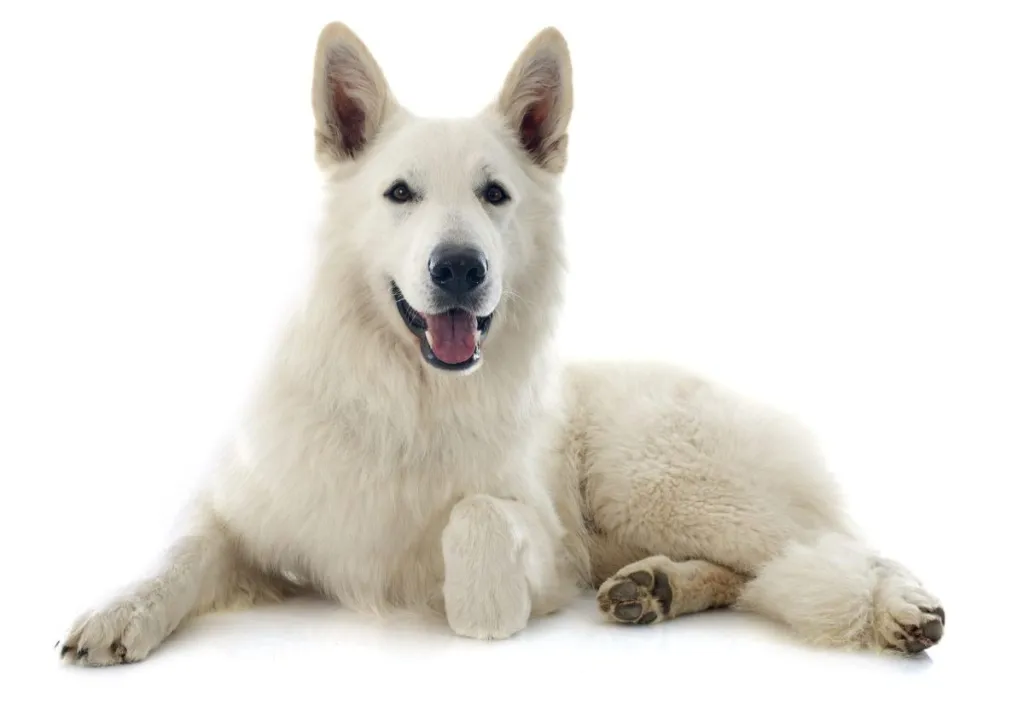The White Shepherd, alternatively referred to as the American White Shepherd Dog or White German Shepherd, is a medium-sized working and herding dog breed developed in the United States. These dogs share a lineage with the white-coated German Shepherd Dog.
In 1933, a revision to German breed standards classified white coats as a disqualifying characteristic, effectively prohibiting the registration of white German Shepherds within the country. This development spurred the independent development of the White Shepherd breed in the United States and Canada.
White Shepherd Characteristics
- Height: Male: 24–26 inches (60–65 cm) Female: 22–24 inches (55–60 cm)
- Lifespan: 12-14 years
- Weight: Male (77–88 pounds) Female (71–77 pounds)
Coat and Colors
White Shepherds possess a dense, double coat that can vary from a pure white to a cream or ivory shade. Their coat requires regular grooming to maintain its appearance.
Physical Traits and Appearance
With a muscular, athletic build, White Shepherds are an alert, intelligent, and confident breed. They have a wedge-shaped head, erect ears, and a long, bushy tail. Their eyes are typically brown.
White Shepherd Temperament
Choosing the right dog breed goes beyond just appearance and price. Considering a dog’s temperament is crucial to determine if the dog is a compatible match for your lifestyle. The right temperament creates an amicable home for both of you.
Personality and Behavior
Much like their German Shepherd cousins, this breed shares some of the same personality and behavioral traits with a few noticeable exceptions. Originally bred with German sheepdogs, White Shepherds inherited those herding instincts – and the protective instincts of the German Shepherd.
White Shepherds possess a more laid-back compared to their German Shepherd relatives. This doesn’t translate to a lack of attentiveness, however. Their protective instincts remain strong, keeping them vigilant watchdogs. While they might initially come across as aloof and cautious around strangers, this behavior stems from a place of careful observation rather than fear or timidity. Essentially, White Shepherds take their time warming up to new people, but their initial reservedness shouldn’t be mistaken for anything more.
Training and Socialization
White Shepherds respond well to positive reinforcement training methods. Early socialization is crucial to prevent potential shyness or aggression. Consistent training and mental stimulation are essential for this breed.
White Shepherd Care
- Understanding the grooming needs of a specific breed helps you choose a dog that fits your lifestyle and avoids grooming surprises.
- Matching your activity level with a dog’s exercise requirements is crucial for their physical and mental well-being. Choosing a breed with compatible energy levels ensures a happy and healthy dog.
- Dietary needs vary across breeds. Selecting a dog breed with dietary requirements that align with your budget and feeding preferences fosters optimal health and prevents potential health complications.
Grooming Needs
White Shepherds shed moderately year-round, brace yourself for coat blow as the seasons change. This twice-a-year phenomenon necessitates thorough brushing to remove the loosened undercoat. Unfortunately, for allergy sufferers, White Shepherds might not be the ideal dog.
Exercise Requirements
As an active breed, they require daily physical and mental exercise. Long walks, hiking, and participation in canine sports can help meet their exercise needs.
Feeding and Nutrition
High-quality dog food formulated for large breeds is recommended. Portion sizes should be adjusted based on age, activity level, and metabolism.
White Shepherds and Family Compatibility
Welcoming a new dog member into your family is an exciting time. we recommend breeds with a gentle nature and adaptability. These family-friendly companions thrive in households with children and adjust well to various living situations, be it a spacious house or a cozy apartment.
However, a family-friendly dog won’t always show the same friendliness to pets. This could manifest as dominance, territorial behavior, or even fighting with fellow dog housemates.
Are White Shepherds Good with Children?
White Shepherds are good with children if socialized from an early age. They are patient and protective guardians well-suited for families with kids.
Are White Shepherds Good with Other Pets?
With early introductions and proper training, they can coexist with other pets.
Apartment Living
White Shepherds can adapt to apartment living if they receive regular exercise, like walks, playtime, and mental stimulation.
Preparing for a Puppy
Proper puppy-proofing, socialization, and training are essential for raising a well-adjusted puppy. Enrolling in puppy classes is highly recommended.
White Shepherd Health Issues
As with any dog, you should keep up with your regular veterinary checkups to detect any health concerns early. Your vet can help you develop a care routine that will keep your dog healthy. Here are some common White Shepherd health issues:
Finding a Breeder
Finding a reputable breeder is essential. Look for breeders who prioritize health testing, temperament evaluation, and adherence to breed standards. We here at DogTime advocate for adoption or rescue, we understand the necessity of ethical breeding practices.
The White Shepherd is recognized by the United Kennel Club (UKC). We recommend using their breeder directory as a starting point for your search.















